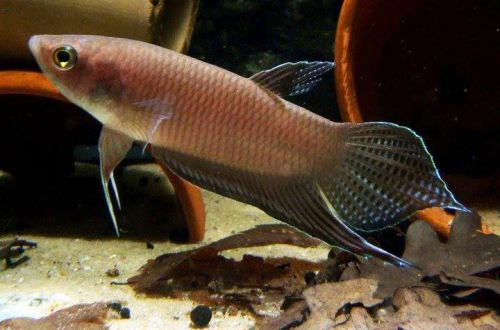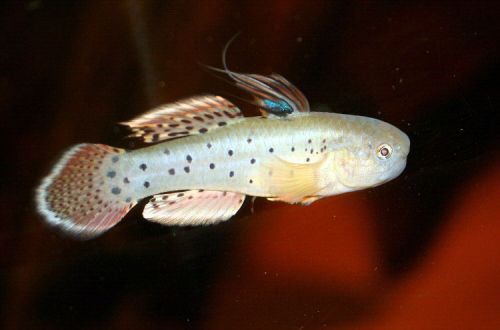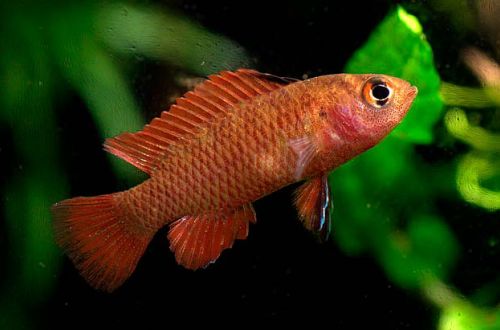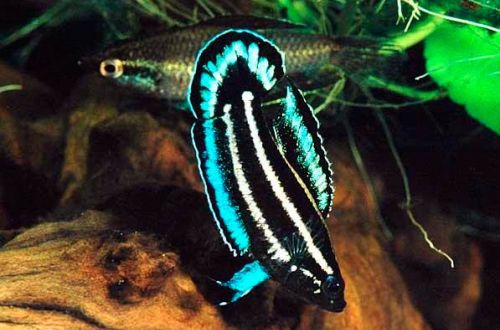
Betta Balunga
Balunga Betta or Balunga Cockerel, scientific name Betta balunga, belongs to the Osphronemidae family. The fish got their name from the area on the island of Borneo where they were first discovered. They have specific water composition requirements (slightly acidic and mild pH and dGH), which can be difficult for a beginner to meet and are therefore not recommended for beginner aquarists.

Contents
Habitat
It comes from Southeast Asia from the Malaysian part of the island of Borneo from the province of Sabah. Inhabits the Balung River basin. A typical biotope is shallow streams only 5–10 cm deep, running under a dense rainforest canopy. The channel is littered with a layer of fallen leaves and branches, and the banks are covered with dense thickets of plants, mosses and ferns.
Brief information:
- The volume of the aquarium – from 50 liters.
- Temperature – 22-27°C
- Value pH — 5.0–7.0
- Water hardness – 1–5 dGH
- Substrate type – any dark
- Lighting – subdued
- Brackish water – no
- Water movement – little or no
- The size of the fish is about 5 cm.
- Food – any food
- Temperament – peaceful
- Content – in a pair or group together with other species
Description
Adult individuals reach a length of about 5 cm. Males, unlike females, are somewhat larger and have a pointed fin shape. Differences are also observed in coloration. Males have light stripes on a gray background, and fins have turquoise hues. Females, in turn, are colored more uniformly.
Food
The basis of the diet in the wild are small insects and other zooplankton. The home aquarium will accept alternative foods, such as dry, frozen and live foods popular in the aquarium trade.
Maintenance and care, arrangement of the aquarium
The optimal size of the aquarium for a small group of fish starts from 50-60 liters. Natural or artificial design elements are selected in such a way as to form several places for shelters. A good choice would be a combination of thickets of shade-loving plants and snags. Sheet litter will give the design more naturalness and at the same time serve as a means of saturating the water with tannins, thereby repeating the processes occurring in the natural habitat of Betta Balunga. Read more in the article “Which tree leaves can be used in an aquarium.”
Maintaining high water quality within an acceptable range of temperatures and hydrochemical parameters is of key importance for long-term maintenance. A stable aquatic environment is ensured by the regular maintenance of the aquarium and the smooth operation of the equipment, primarily the filtration system.
Behavior and Compatibility
Peaceful calm fish. There is competition between males for position in the intraspecific hierarchy and for the attention of females, which manifests itself in a “demonstration of strength”. Unlike other Petushkas, skirmishes are rare and not violent. Can be supported in a male / female pair or in a small heterosexual group. Perfectly compatible with other non-aggressive species of comparable size.
Breeding / breeding
Balunga cockerels take care of their offspring at the most vulnerable stage of development. They do not spawn on the ground or among plants, leaving the masonry to their fate, as many other fish do, but they hatch eggs in their mouths, and males do this. Females at this time are engaged in the protection of the site where the male retired. It is worth noting that females in this species play a more active role, and it is they who initiate the courtship process during the breeding season.
The incubation period lasts 14–21 days, after which fully formed fry appear. From this moment, the parents no longer pay attention to their brood, but at the same time they do not try to eat it, so the juveniles can grow up with adult fish. However, it is worth remembering that if representatives of other species live in the aquarium, then they will consider the new generation of Betta as an additional source of food.
Fish diseases
The cause of most diseases is unsuitable conditions of detention. A stable habitat will be the key to successful keeping. In the event of symptoms of the disease, first of all, the quality of the water should be checked and, if deviations are found, measures should be taken to correct the situation. If symptoms persist or even worsen, medical treatment will be required. Read more about symptoms and treatments in the Aquarium Fish Diseases section.





